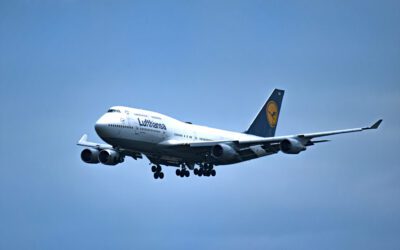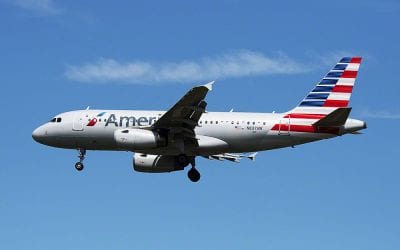Countless passengers can’t sleep while flying, even on long night flights with the cabin’s main lighting off and all window shades pulled down. They work, read or otherwise entertain themselves the entire flight.
Unfortunately, by staying awake all night, whether through multiple time zones or just one or two, long distance fliers exacerbate their potential jet lag. Often, on arrival back home or at their destination, those who stayed awake through the night find they have a tough case of jet lag, which will last until their “biological clock” eventually resets.
The overall environment in planes’ cabins makes it hard to get a restful sleep. The anticipation of arriving at one’s destination or getting home can make the traveler’s mind race, also preventing sleep.
 According to the National Sleep Foundation, “noises at levels as low as 40 decibels or as high as 70 decibels can keep us awake”; even more so if they’re unfamiliar, like the drone of jet engines, lavatory and galley traffic and passengers’ activities. Cabin temperatures that are too high or low disrupt sleep. Light, such as nearby reading lights, galley or lavatory lights, can keep us awake. The extremely low humidity in most airplane cabins rapidly dehydrates us, causing dry eyes, mouth and thirst. The seats in economy aren’t helpful either, with a poor sleeping surface and seat backs which are mostly upright, even when fully reclined.
According to the National Sleep Foundation, “noises at levels as low as 40 decibels or as high as 70 decibels can keep us awake”; even more so if they’re unfamiliar, like the drone of jet engines, lavatory and galley traffic and passengers’ activities. Cabin temperatures that are too high or low disrupt sleep. Light, such as nearby reading lights, galley or lavatory lights, can keep us awake. The extremely low humidity in most airplane cabins rapidly dehydrates us, causing dry eyes, mouth and thirst. The seats in economy aren’t helpful either, with a poor sleeping surface and seat backs which are mostly upright, even when fully reclined.
Sometimes passengers are their own worst enemies. On those night flights from the US east coast to Europe, for example, soon after takeoff and shortly before the flight attendants darken the cabin, snacks and beverages are served. Many have an alcoholic beverage, coffee, tea or cola. Those beverages are both stimulants and diuretics. They’ll tend to keep passengers awake and wake them later to use the lavatory.
Here are my eight tips for getting a restful sleep while you’re flying:
1. Consider flying business class. I know it can cost thousands of dollars, but if you have some frequent flier miles stored up (60,000 for a US-European round trip flying US Air), you can use them to upgrade to business class. Business class seats are far more comfortable than in economy, significantly wider and can generally lie flat, essentially forming a bed for your overnight sleep. People I know who can never sleep in economy seats get a restful sleep when flying business class.
I think upgrades are the best use of frequent flier miles and have used them that way for years.
2. Fly a 787 or A350. The carbon-fiber-based Boeing 787 (soon the Airbus A350, too) has a much more comfortable cabin environment than other commercial scheduled aircraft flying today.
The other planes are primarily made of aluminum. To limit weakening their fuselages from repeated cabin pressurizations and potential corrosion, they’re pressurized to 8,000 feet above sea level, with cabin humidity limited to 4 percent. The carbon-fiber-based 787 is pressurized to a more comfortable 6,000 feet above sea level and its cabin humidity can be kept at 15 percent.
Choose to fly a 787 or A350 instead of aluminum-based planes for a more comfortable, restful cabin environment, if available for your flights.
3. Use an inflatable pillow. If you’re in economy, as you’ll be trying to sleep while sitting, consider an inflatable neck pillow with a soft cover to keep you comfortable and prevent neck kinks. Some travel veterans bring their own full down pillow that compresses into a small packet.
4. Block out cabin noise. For that and the drone of the engines, inexpensive, disposable foam earplugs work great. I’ve been using them for years. (They’re great in noisy hotels, too.) You insert them in your ear and they form fit to block the noise. Some travelers swear by noise-canceling headphones.
5. Wear layers. You never know how comfortable the cabin temperature will be. A couple of years ago, flying Lufthansa between the US and Frankfurt, our plane was very hot to Europe, but freezing coming home. To stay comfortable, wear layers when you fly so you can adjust your clothing to the cabin temperature. Make sure you have some kind of jacket or cover-up, even in summer, in case of a cold cabin.
6. Wear an eye mask. I used to wear a silk eye mask when flying to keep light out of my eyes to sleep. While lightweight and comfortable, I would occasionally awaken when my eyelashes came in contact with the mask. I recommend using an adjustable pre-formed eye mask which can’t contact your eyes or lashes, even during REM sleep. Fit is crucial, however, so make sure it’s returnable.
7. Lubricate your eyes. To keep my eyes comfortable, I often use an over-the-counter, preservative-free lubricant eye drop before going to sleep to prevent dry, itchy eyes.
8. Stay away from caffeine and alcohol. To make sure I stay comfortably hydrated and not need to constantly trek to the lavatory, I stay away from alcoholic beverages, as well as coffee, regular tea, cola and citrus juices, while aloft. I stick mainly with water, but also drink tomato juice, herbal tea, or cranberry and apple juice if available, which are neither stimulants or diuretics.
Happy sleeping while aloft. Please add any of your tips for long-distance overnight flights that can be used by others for a better night’s sleep.
[poll id=”50″]



